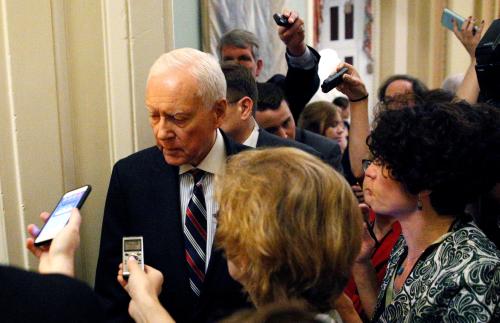This analysis is part of USC-Brookings Schaeffer Initiative on Health Policy, which is a partnership between the Center for Health Policy at Brookings and the University of Southern California Schaeffer Center for Health Policy & Economics. The Initiative aims to inform the national health care debate with rigorous, evidence-based analysis leading to practical recommendations using the collaborative strengths of USC and Brookings.
This analysis was published prior to the release of legislative text of Cruz’s proposal on July 13, 2017. However, the regulatory framework created by Cruz’s amendment largely conforms to the “base scenario” analyzed here.
Senate Republicans are considering an amendment to the Better Care Reconciliation Act (BCRA) proposed by Sen. Ted Cruz that would relax a range of regulations on individual market insurance plans introduced in the Affordable Care Act (ACA). While no formal legislative language has been introduced, Cruz’s proposal would allow insurers that offer at least one ACA-compliant plan to offer “non-compliant” plans that do not abide by ACA regulations. Non-compliant plans would apparently be exempt from the “community rating” and “guaranteed availability” requirements that bar insurers from denying coverage or varying premiums based on health status, as well as the requirements to cover a specified list of “essential health benefits” and provide certain protections against catastrophic costs.
Cruz has presented his proposal as a way to reconcile Senate conservatives’ desire to eliminate community rating and other market regulations with other Republicans’ desire to maintain regulatory protections for people with significant health care needs. In fact, however, the Cruz proposal would seriously weaken protections for people with significant health care needs, while also likely increasing federal costs and causing adverse shifts in who has coverage and what types of coverage they have. Cruz’s proposal would compound the already significant reductions in the extent and quality of insurance coverage caused by the underlying provisions of the BCRA.
In brief, because non-compliant plans could vary premiums based on health status, they could offer lower premiums to healthier enrollees, which would trigger an exodus of healthy enrollees from the ACA-compliant market. Non-compliant plans’ ability to offer skimpier coverage would also help them siphon healthier enrollees away from the ACA-compliant market. The loss of healthier enrollees from the ACA-compliant market would, in turn, necessitate very large premium increases for ACA-compliant plans.
Enrollees with incomes low enough to qualify for tax credits under the BCRA would be largely protected against these premium increases provided they purchased the benchmark plan. However, enrollees with significant health care needs and incomes too high to qualify for tax credits would be left with two unappealing choices: purchase an ACA-compliant policy at a very high premium, or, alternatively, seek coverage in the non-compliant market, where they could be charged a high premium reflecting their poor health, sold a policy that excluded coverage for a pre-existing condition, or denied coverage entirely. The increase in ACA-compliant premiums would also most likely increase the cost of the BCRA’s tax credits to the federal government.
In addition to shifting costs toward sicker enrollees and the federal government, the Cruz proposal would likely cause undesirable shifts in who has coverage and the types of coverage they have. Higher premiums for sicker enrollees would cause reductions in the extent and quality of coverage for that group. While healthier people would face lower premiums, which would likely increase the extent and quality of their coverage, the magnitude of the premium increases faced by sicker enrollees, together with the fact that healthier enrollees are less likely to need their coverage, would likely make this a poor trade off on net. Insurers’ ability to offer skimpy non-compliant plans would also drive adverse selection against more generous plan types, increasing the cost of more generous plans and thereby, at least partially, offsetting improvements in coverage quality among healthier enrollees due to lower premiums.
The remainder of this blog post examines the Cruz proposal in greater detail.
Major Features of the Cruz Proposal
Senator Cruz has not released formal legislative language for his proposal, but a picture of its major features can be obtained from a one-page summary released by his office, a “pocket card” he shared with other Senators, and his recent statements to reporters. Under the proposal, insurers that offered at least one ACA-compliant individual market plan in a given geographic area would also be permitted to sell “any other plan that consumers want” in that geographic area. The proposal would, in essence, create two parallel insurance markets, one for ACA-compliant plans and one for non-compliant plans.
The proposal would, in essence, create two parallel insurance markets, one for ACA-compliant plans and one for non-compliant plans.
The various written materials Cruz has provided, as well as his press statements, imply that non-compliant plans permitted under Cruz’s proposal would be exempt from all of the regulatory requirements included in “Title One” of the ACA. That category includes the guaranteed availability and community rating requirements that bar insurers from denying coverage or varying premiums based on health status. It also includes the essential health benefit requirements that govern what services individual market insurance plans must cover, as well as various requirements that govern the level of financial protection plans must provide, like the requirement that plans have an actuarial value of at least 60 percent, the requirement that plans limit annual out-of-pocket spending, and the prohibition on annual and lifetime limits. It seems likely that non-compliant plans would also be exempt from the ACA’s risk adjustment mechanisms.
The way in which Cruz’s proposal would be integrated with the BCRA’s premium tax credits would have major effects on how it functioned. Under the base BCRA, people with incomes below 350 percent of the federal poverty level would be eligible for tax credits. The credits would limit individuals’ contribution toward a benchmark plan (in the case of the BCRA, an ACA-compliant plan with an actuarial value of 58 percent) to a specified share of income, which would vary by age and income level.
The most natural interpretation of the one-page summary released by Cruz’s office and Cruz’s statements to reporters is that the benchmark plan for determining the amount of premium tax credits would continue to be an ACA-compliant plan and tax credits could only be used to purchase ACA-compliant plans. I assume that this is the correct interpretation of Cruz’s proposal for my initial analysis of Cruz’s proposal. However, I also consider the implications of alternative interpretations.
The Individual Insurance Market Would Bifurcate Under the Cruz Proposal
Creating parallel insurance markets that operated under very different rules would, as other analysts have noted, cause individual market enrollees to sort themselves across the two markets by health status. People with significant health needs would purchase coverage in the ACA-compliant market, while many healthy people—particularly those with incomes too high to qualify for premium tax credits or who qualified for comparatively small tax credits—would purchase non-compliant coverage. Two features of the Cruz proposal would generate this sorting by health status.
First, insurers would be permitted to vary premiums for non-compliant plans (as well as other aspects of coverage) or deny coverage based on enrollee characteristics observed during the medical underwriting process.[1] As a result, people who insurers judge to be relatively healthy would face lower premiums in the non-compliant market than in the ACA-compliant market, where premiums would still not depend on health status. By contrast, people who insurers judged to be less healthy would be charged higher premiums, only offered policies that excluded care for pre-existing conditions, or denied coverage entirely in the non-compliant market, so they would generally be better off purchasing coverage in the ACA-compliant market.
Second, insurers would be permitted to offer plans in the non-compliant market that did not meet the ACA’s standards with respect to benefits and cost sharing. This would induce additional sorting, including on dimensions of health status that insurers could not observe during the underwriting process. For example, insurers could offer plans that did not cap annual out-of-pocket spending or that imposed annual and lifetime limits on benefits. Alternatively, insurers could carve out coverage for services like maternity care or substance abuse and mental health treatment, as was common prior to the ACA. These types of plans would be most attractive to people who expected to have limited health care needs, permitting these plans to be offered at relatively low premiums. For many healthier people, those lower premiums would be sufficient to make up for the fact that these plans offered less financial protection, providing an additional inducement for healthier enrollees to opt for non-compliant coverage.
Without the BCRA’s tax credits, the forces unleashed by Cruz’s proposal would cause the ACA-compliant market to completely unravel. As healthy people left for the non-compliant market, premiums in the ACA-compliant market would rise, increasing the number of people who could get a better deal in the non-compliant market. This cycle of rising premiums and falling enrollment would continue until ACA-compliant premiums reached such a high level that virtually no one remained enrolled in the ACA-compliant market.
The outcome would not be quite as extreme with the BCRA’s tax credits in place. Because tax credits would only be available in the ACA-compliant market, some people with incomes low enough to qualify for tax credits—including some who were relatively healthy or, at a minimum, not that unhealthy—would face lower premiums for ACA-compliant plans than for non-compliant plans. And because the value of the tax credit increases dollar-for-dollar with the premium of the benchmark plan, the ACA-compliant market would remain more attractive to these people even as ACA-compliant premiums rose. Continued enrollment from this group would likely keep the ACA-compliant market from completely unraveling, putting some upper limit on how high ACA-compliant premiums would go under the Cruz proposal.
Exactly how high premiums in the ACA-compliant market would be when the market ultimately stabilized is difficult to say without detailed microsimulation modeling, but there is no doubt that they would be dramatically higher than in the absence of Cruz’s proposal. Notably, in analyzing the base BCRA, the Congressional Budget Office (CBO) concluded that relatively few low-income people would enroll in the individual market due to the BCRA’s relatively stingy premium tax credits and the lack of cost-sharing reductions. Since low-income enrollees are the most likely to find that the availability of tax credits makes coverage on ACA-compliant market more attractive than coverage on the non-compliant market, the limited number of enrollees in these income ranges would, in turn, limit the extent to which the BCRA’s tax credits would keep the ACA-compliant market from unraveling under Cruz’s proposal.
Whatever the new equilibrium might be, the transition would likely be quite messy in practice. Insurers would find it challenging to predict exactly what the risk pool in ACA-compliant plans would look like under the new rules. Recent experience provides ample evidence that insurers are highly averse to uncertainty, so it is possible that some insurers would elect to reduce their participation in the individual market or withdraw from the market entirely until it became clearer how the new market structure was functioning. Alternatively, they might remain in the market but set premiums that are even higher than what they think might ultimately be required to protect themselves against uncertainty in the interim.
Cruz’s proposal Would Reduce the Individual Market’s Effectiveness and Increase Federal costs
The changes caused by the Cruz proposal would weaken the individual market’s ability to perform the core functions of an insurance market: pooling risk between the healthy and the sick, providing financial protection against unexpected health shocks, and ensuring access to needed health care.
Most directly, the increase in ACA-compliant premiums would sharply raise premium burdens for many people with significant health care needs, whose only viable option for obtaining coverage would be to remain in the ACA-compliant market. Although people with incomes low enough to qualify for tax credits would be protected against these increases, individual market enrollees with higher incomes would bear the full increase. Healthy people would, of course, pay lower premiums, but this shift in premium burdens from the healthy to the sick would, by definition, worsen the market’s effectiveness at pooling risk and providing financial protection.
The increase in ACA-compliant premiums would sharply raise premium burdens for many people with significant health care needs, whose only viable option for obtaining coverage would be to remain in the ACA-compliant market.
The shift in the premium burden toward sicker enrollees would also drive potentially damaging shifts in who had insurance coverage and what types of coverage they had. As noted above, sicker people with incomes too high to qualify for tax credits would now face much higher premiums, which would cause coverage in this group to decline significantly. Additionally, due to the worsened ACA-compliant risk pool, everyone enrolled in the ACA-compliant market—including people eligible for tax credits—would face large increases in the cost of purchasing more generous coverage, driving some of these enrollees to purchase skimpier coverage. Lower premiums for healthier enrollees would likely drive increases in the extent and quality of coverage in this group. However, since the increases in premiums for sicker enrollees would be particularly large and sicker enrollees are particularly likely to make use of their coverage, it is likely that the individual market would become less effective in providing financial protection and ensuring access to care on net.
The expansion in the range of plan designs that insurers could offer would also likely drive inefficient reductions in the generosity of individual market coverage among healthier enrollees, undermining both financial protection and access to care for these enrollees. As noted in the last section, many insurers would offer policies that covered fewer services or required greater cost-sharing that were designed to siphon healthy enrollees away from more generous plans and thereby increase premiums for these plans. This would induce many healthier enrollees to switch to less generous plans even though they valued the additional coverage at more than the cost of providing it.
In addition to its adverse effects on insurance markets, the Cruz proposal would very likely increase the BCRA’s cost to the federal government, possibly significantly. Because the value of tax credits rises dollar-for-dollar with the premium of the benchmark plan, the large run-up in premiums on the ACA-compliant market would greatly increase the federal government’s cost of providing those tax credits. The costs associated with the increase in premiums could be offset to some degree by a reduction in the number of people receiving tax credits, as some healthy individuals, particularly those eligible for comparatively modest tax credits, would opt to shift into the non-compliant market. However, precisely because the tax credit recipients who would shift to the non-compliant market would be relatively healthy and eligible for comparatively modest credits, the resulting reduction in federal costs would likely be relatively small; indeed, it is possible that the adverse effects on the risk pool from the departure of subsidized enrollees would be so large that their departure would actually increase federal costs.[2]
How Would the Effects of the Cruz Proposal Differ Under Different Assumptions About Tax Credits?
The analysis above assumes that the benchmark for determining the amount of the premium tax credit would continue to be an ACA-compliant plan and tax credits would only be available for ACA-compliant plans. As I noted earlier, this is the most likely interpretation in light of what is known about Cruz’s proposal. But since definitive information is not available, it is also worth considering two alternative interpretations of the Cruz proposal. Either of these alternatives would exacerbate the Cruz proposal’s adverse effects on people with significant health care needs.
Alternative Assumption #1: Tax credits would be based on the premiums of non-compliant plans
As discussed above, the Cruz proposal would likely increase federal costs under my base assumptions, which might be unappealing to many conservatives. It is conceivable that Cruz intends to avoid this problem by linking the amount of the tax credit to the premiums of non-compliant plans rather than ACA-compliant plans. Any such linkage would likely have to be relatively crude given the lack of plan standardization in the non-compliant market and the fact that premiums for the same plan would vary from person to person. However, one straightforward approach would be to set the benchmark premium at some percentage of the average premium in the non-compliant market. While there are a range of possible approaches, the qualitative effects of the Cruz proposal would be similar under any approach in which the value of the tax credit no longer varied dollar-for-dollar as ACA-compliant premiums.
With this modification, the Cruz proposal would cause the ACA-compliant market to completely unravel, an even worse outcome than the very-high-premium equilibrium that Cruz’s proposal would produce under my base assumptions. Under my base assumptions, people eligible for tax credits would have been largely protected as ACA-compliant premiums rose, causing some comparatively healthy people in that group to remain in the ACA-compliant market. Under this alternative version of the proposal, the tax credits would no longer increase dollar for dollar with ACA-compliant premiums, so even people eligible for comparatively large tax credits would leave the ACA-compliant market as premiums rose. In the end, ACA-compliant premiums would reach an extremely high level, likely so high that virtually no one would remain enrolled in the ACA-compliant market.
This version of the Cruz proposal would be even worse for people with significant health care needs. Whereas sicker people would have at least had the option of paying a high, but not necessarily prohibitively high, premium in the ACA-compliant market under my base assumptions, that option would effectively disappear in this scenario. These individuals’ only option would be to attempt to enroll through the non-compliant market, where coverage would either be very expensive or completely unavailable. Furthermore, since the tax credit would no longer be linked to ACA-compliant premiums, sicker people with incomes low enough to qualify for tax credits would no longer be protected. The smaller tax credit would, however, succeed in reducing federal spending.
Alternative Assumption #2: Tax credits could be used to purchase non-compliant plans
It is also possible that Cruz intends to allow enrollees to use tax credits to purchase non-compliant plans. Like the first alternative discussed above, this modification would also cause the ACA-compliant market to completely unravel. Under my base assumptions, the tax credit would have kept some comparatively healthy people in the ACA-compliant market. But with tax credits available in the non-compliant market, these people would be better off using the tax credit to purchase non-compliant coverage. Progressively more individuals would have an incentive to desert the ACA-compliant market as premiums rose, causing ACA-compliant premiums to reach an extremely high level and causing compliant-market enrollment to fall to an extremely low level.
This version of Cruz’s proposal would also be worse for sick people with incomes too high to qualify for subsidies than the base set of assumptions. Whereas these individuals would have at least had the option of paying a high, but not necessarily prohibitively high, premium in the ACA-compliant market under my base assumptions, that option would effectively disappear under this alternative assumption, leaving the non-compliant market as their only option. On the other hand, many people eligible for tax credits—including some people of below-average health—would be better off; they could use the tax credits, which would now be based on the extremely high ACA-compliant premiums, to purchase non-compliant plans at very low net premiums.
However, it is doubtful that this version of the proposal would be viable in practice, as providing those tax credits would be prohibitively expensive for the federal government. Because the ACA-compliant market would have completely unraveled, ACA-compliant premiums would be effectively infinite, meaning that the per-person cost of providing tax credits would be extremely large. Furthermore, the number of people receiving tax credits would probably be considerably larger than under the base BCRA. As a result, the increase in federal costs relative to the base BCRA would reach well into the hundreds of billions over ten years and quite possibly higher.[3]
Other Proposals to Create Parallel Insurance Markets Would Create Similar Problems
The Cruz proposal is not the only proposal that has arisen during the current health care debate that would allow enrollees to choose among plans that are and are not subject to major ACA regulatory requirements. Any proposal of this form is likely to have a similar outcome: an exodus of healthier individuals from ACA-compliant plans and correspondingly large increases in ACA-compliant premiums.
Any proposal of this form is likely to have a similar outcome: an exodus of healthier individuals from ACA-compliant plans and correspondingly large increases in ACA-compliant premiums.
Notably, the BCRA currently includes a provision that would allow certain types of membership organizations, commonly referred to as “associations,” to sell insurance coverage to small employers and the self-employed. These association health plans (AHPs) would be regulated like large group market coverage, so they would not be subject to the essential health benefit requirements that govern what services individual and small group market plans must cover.[4] Most importantly, while association health plans might not be able to charge different premiums to different members of the association or offer coverage to some member but not others, they likely could keep employers whose employees had significant health care needs from joining the association in the first place, thereby allowing AHPs to form pools that consisted largely or entirely of healthier individuals.[5]
As Karen Pollitz and Gary Claxton have noted, the BCRA’s AHP provision could spur a significant exodus of small employers with healthier workforces from the small group market, driving up premiums in the small group market in much the same way the Cruz proposal would undermine the ACA-compliant individual market. The AHP provision would also likely have some effect on the individual market since self-employed individuals constitute a non-trivial fraction of individual market enrollees. And if the BCRA’s AHP provision were expanded to allow AHPs to offer coverage to all individuals, including people who are not self-employed, as Sen. Rand Paul has recently proposed, then the extent of the disruption in the individual market could approach what would occur under the Cruz proposal.
Similarly, the House-passed American Health Care Act (AHCA) contained a provision that would have had this effect on the individual market in many states. Under the AHCA, states could have applied for waivers to allow insurers to vary premiums based on health status for people with a recent gap in coverage. In practice, however, it likely would have been possible for healthier individuals to decline to document their prior coverage status and thereby opt into paying a premium based on health status. Because of the structure of the AHCA’s tax credit, healthy people at all income levels would have had a strong incentive to opt out of the community rated pool. As a result, as I discussed in an earlier analysis, premiums in the community rated pool would have risen to extremely high levels, effectively eliminating the guarantee that people with serious illnesses could access coverage. CBO reached a similar conclusion in its analysis of the AHCA.
[1] The effect of the Cruz amendment would be essentially identical if non-compliant plans were not allowed to outright deny coverage based on health status. Plans could simply quote an exorbitant premium to those individuals they did not wish to cover, which would keep them from enrolling as well as an outright bar.
[2] To see how the departure of subsidized enrollees could actually increase federal costs, note that subsidized enrollees would account for the sizeable majority of the ACA-compliant market under the compliant market. As the subsidized share approaches 100 percent, the federal government’s tax credit cost becomes increasingly well approximated by total claims costs in the ACA-compliant market minus enrollees’ income-based premium contributions. This implies that when a subsidized enrollee leaves the market, the net change in federal costs would be approximately equal to the difference between the enrollee’s premium contribution and her claims costs. But the subsidized enrollees most likely to leave the ACA-compliant market are those whose premium contributions exceeds their expected claims costs, which would cause federal costs to actually rise. Of course, if the subsidized share is significantly less than 100 percent, then reductions in subsidized enrollment could have the more conventional effect of reducing federal costs, but any such reductions would likely be relatively small.
[3] Under this scenario, the amount of the tax credit would likely exceed the premium of even a very generous plan for the sizeable majority of enrollees. Since enrollees would presumably not be able to “cash out” the excess amount of any credit, insurers would likely attempt to provide various types of ancillary benefits through their non-compliant policies. The extent to which the federal government was successful in blocking that type of behavior would be an important determinant of the proposal’s ultimate cost.
[4] The BCRA refers to these plans as “small business health plans,” rather than as “association health plans.” However, because the term “association health plan” is more commonly used in discussing these types of proposals, including in Senator Paul’s proposal to expand this BCRA provision, I use that term here.
[5] The only major criterion an association would need to satisfy is demonstrating that it had been “established for a purpose other than providing health benefits.” This requirement would likely not block organizations from conditioning membership based on health status. In addition, as Karen Pollitz and Gary Claxton have noted, it would likely not be a significant barrier to the establishment of AHPs since there is no requirement that an association’s “primary purpose” be something other than providing health benefits.






Commentary
Sen. Cruz’s proposed change to Senate health care bill would undermine protections for enrollees with significant health care needs
July 12, 2017